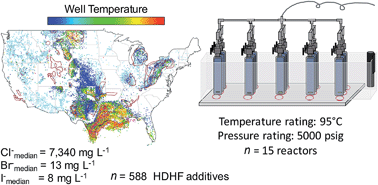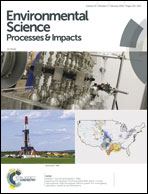Exploring the hydraulic fracturing parameter space: a novel high-pressure, high-throughput reactor system for investigating subsurface chemical transformations†
Abstract
Hydraulic fracturing coupled with horizontal drilling (HDHF) involves the deep-well injection of a fracturing fluid composed of diverse and numerous chemical additives designed to facilitate the release and collection of natural gas from shale plays. Analyses of flowback wastewaters have revealed organic contamination from both geogenic and anthropogenic sources. The additional detections of undisclosed halogenated chemicals suggest unintended in situ transformation of reactive additives, but the formation pathways for these are unclear in subsurface brines. To develop an efficient experimental framework for investigating the complex shale-well parameter space, we have reviewed and synthesized geospatial well data detailing temperature, pressure, pH, and halide ion values as well as industrial chemical disclosure and concentration data. Our findings showed subsurface conditions can reach pressures up to 4500 psi (310 bars) and temperatures up to 95 °C, while at least 588 unique chemicals have been disclosed by industry, including reactive oxidants and acids. Given the extreme conditions necessary to simulate the subsurface, we briefly highlighted existing geochemical reactor systems rated to the necessary pressures and temperatures, identifying throughput as a key limitation. In response, we designed and developed a custom reactor system capable of achieving 5000 psi (345 bars) and 90 °C at low cost with 15 individual reactors that are readily turned over. To demonstrate the system's throughput, we simultaneously tested 12 disclosed HDHF chemicals against a radical initiator compound in simulated subsurface conditions, ruling out a dozen potential transformation pathways in a single experiment. This review outlines the dynamic and diverse parameter range experienced by HDHF chemical additives and provides an optimized framework and novel reactor system for the methodical study of subsurface transformation pathways. Ultimately, enabling such studies will provide urgently needed clarity for water treatment downstream or releases to the environment.

- This article is part of the themed collections: Best Papers 2018 – Environmental Science: Processes & Impacts and Best Papers from 2018 in the Environmental Science Family of Journals


 Please wait while we load your content...
Please wait while we load your content...